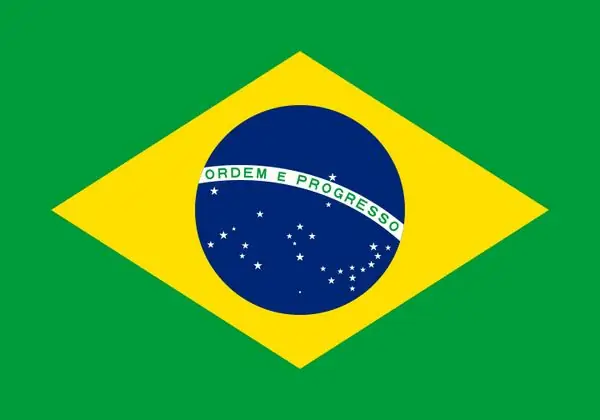- Author Antonio Harrison [email protected].
- Public 2023-12-16 07:44.
- Last modified 2025-01-22 21:44.
The history of the Brazilian flag begins in 1822, when the first flag of an independent state appeared. At the end of the 19th century, it changed significantly, and after that only minor amendments were made to its design. The symbolism of colors and elements has changed over time.

Brazilian flag
In 1889, the Brazilian flag was officially adopted, popularly called "gold-green". In 1968, its design changed slightly, and a little later a law on national symbols was passed. The flag received its final modern appearance in 1992.
The Brazilian flag is a rectangular green panel with a yellow rhombus in the middle stretching horizontally. It contains a dark blue circle with many small five-pointed white stars: there are twenty-seven in total, they are grouped into several constellations. The circle is crossed by a white ribbon on which the Brazilian national motto - "Order and Progress" is written.
Brazilian flag insignia
Brazil's modern flag has several features in common with the old flag adopted in 1822 since the country's independence. It used two main colors: green and yellow, which symbolized the royal dynasties of the Habsburgs and Braganza - from which the Brazilian emperor Pedro I and his wife descended. True, the emperor said that green should symbolize spring, and yellow - gold. A blue globe was also present on this flag, enclosed in a shield.
The rest of the elements - the branches of tobacco and coffee, the blue ribbon - have not survived in the modern version.
After the proclamation of Brazil as a republic in 1889, a decree was adopted on the symbolism of the new flag. The new authorities did not want to completely break all ties with the country's past, so they decided to leave the green background with a yellow diamond. The blue ball also remained almost unchanged, but now it did not depict the Earth, but a view of the starry sky with several constellations, the number of stars of which is equal to the number of provinces in the state.
The author of this project drew an image of the constellations of the Southern Cross, Scorpio and the Triangle as seen from space, and not from Earth. But it turned out to be successful, and they decided to leave it. These constellations were visible at the latitude of Rio de Janeiro on the day Brazil became a republic.
When a new province is formed, the number of stars on the blue circle changes.
At the same time, the flag was supplemented with a new element - a white ribbon with a motto, which was borrowed from the French philosopher Comte.
Today, the colors of the flag are explained differently: green means the lush nature of a South American country with a huge number of tropical rainforests around the Amazon, yellow means a wealth of underground minerals (including gold), blue means clear skies overhead, white means peace and tranquility.






